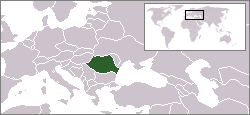| Localization | |
 | |
| Flag | |
 | |
| Basic information | |
| capital | Bucharest |
| Government | Republic |
| Currency | read |
| Area | 238,391 km² |
| Population | 21.698.181 (2002) |
| Language | Romanian |
| Religion | Orthodox Christians, Catholic minorities, Protestants and Muslims |
| Electricity | 220V/50Hz |
| phone code | 40 |
| Internet TLD | .ro |
| Time zone | UTC 2/3 |
THE Romania[1] (or Romania) is a country of Balkans.
Regions

| Transylvania Famous in the stories of Count Dracula, it is a beautiful mountain region, the most famous region of Romania, the land of medieval castles and towns, dark forests, snowy peaks , the same time a region experiencing rapid economical development, with modern youthful cities, huge shopping malls, massive infrastructure projects etc. |
| banat This province is probably the most economically developed in Romania. It has traditional German villages, and large forests with mountains. |
| Oltenia The south-western region, with impressive monasteries, caves and health resorts along the mountains in its northern part and a bizarre desert-like area in the south. |
| bucovine This north-eastern region is famous for its Painted Monasteries, tucked away between picturesque rolling hills. |
| Maramureş The northern-most region, it's best known for its timeless villages, traditional wooden churches and beautiful mountain landscape. |
| child On the border with Hungary, this western region is the entry point for most travelers into Romania, who often neglect its Central-European style cities, numerous medieval sites and resorts on the western side of the Apuseni mountains. |
| Doublegea Coastal province full of ruins of ancient Greek and Roman cities, with several summer resorts in the Black Sea coast and the unspoiled natural beauty of the Danube Delta to the north of the region. Most ethnically diverse region with many small minority groups |
| Moldavia Certainly one of Romania's most extraordinary regions, it offers a delightful mix of historic cities, medieval fortresses, churches, wine and friendly locals. |
| Wallachia Also known as Muntenia. The capital, Bucharest, is in this region, as are the former residences of the Wallachian princes and the mountain resorts in the Prahova Valley. The name corresponds to the old realm of leaders like the notorious Vlad Ţepeş (The Impaler). |
Cities
- Bucharest, capital of the country
- Brasov - an ancient city in the mountains, where legend has it that the castle of Count Dracula is located.
- Cluj-Napoca, the capital of Transylvania
- Timisoara, one of the largest and most cosmopolitan cities in Romania
- Targu-jiu, capital of Gorj , a simple city with squares and parks, very pleasant to live and walk
Other destinations
- O Danube Delta, where the famous river flows into the Black Sea, is an important natural area.
Understand

To arrive
Portuguese and Brazilian citizens do not need a visa for visits. Brazilians can stay for up to 90 days. Citizens of Angola, Mozambique and Cape Verde must obtain a visa and also present a letter of invitation to obtain it.
By airplane
- From Lisbon to Bucharest by plane it can take about 2 to 5 hours, depending on the airline you fly with, as well as the stops. Bucharest airport is called Otopeni. From the airport you can travel by taxi or bus; the metro line is still under construction. Since Romania's entry into the EC, airline ticket prices are cheaper.
- There are no flights from Brazil.
Of boat
It has cruises across the Danube.
By car
Romania has a developed road network compared to other Central European countries. Most of the highway network is located in the south of the country. A large highway is also being built in the north of the country to facilitate circulation. International roads, also marked with an (E), eg E69, are very good roads to circulate.
By bus/bus
By train/train
THE Romanian Railway Company (CFR - page in Romanian, English and French) operates national and international trains.
In 2003, Romania's rail system joined the Eurailpass network, which offers multiple rail travel passes for non-Europeans.
Trains between Romania and Bulgaria are usually slow and very crowded. The 600km journey between Bucharest and Sofia takes 12 hours.
The Dacia Express, which departs from Vienna, provides beautiful panoramas of the Transylvanian countryside.
In Budapest, at Hungary, a long journey (especially the border crossing) passes through Arad towards Bucharest.
Circular
By airplane
Of boat
By car
By bus/bus
By train/train
Speak
The local language is Romanian, a Latin language that has common roots and some similarities to Portuguese. French is widely used as a second language, possibly more than English.
Look

Knife
Buy
With the
drink and go out
sleep
Learn
Work
Safety
Health
respect
Stay in touch
| This article is outlined and need more content. It already follows a suitable model but does not contain enough information. Plunge forward and help it grow ! |

